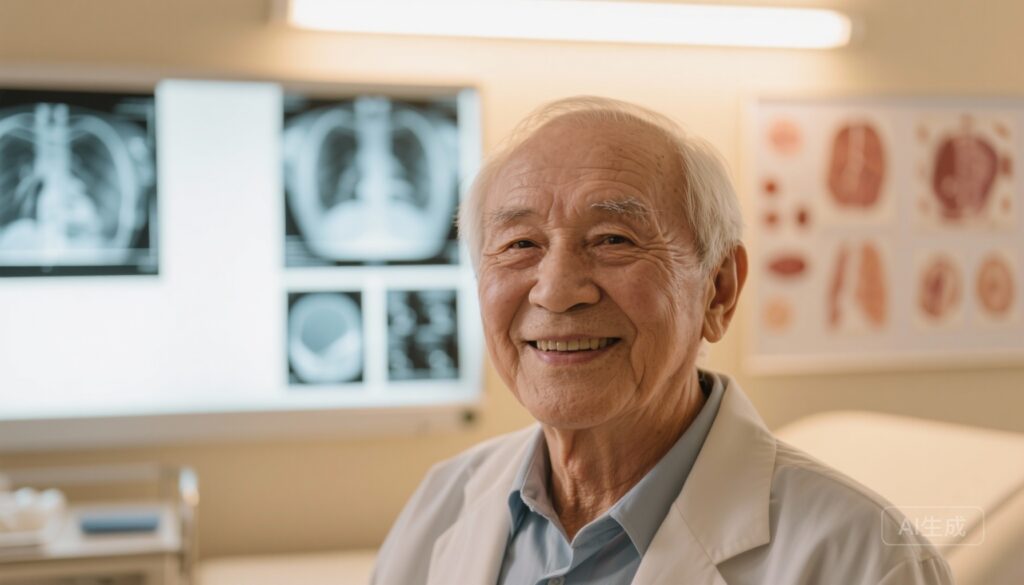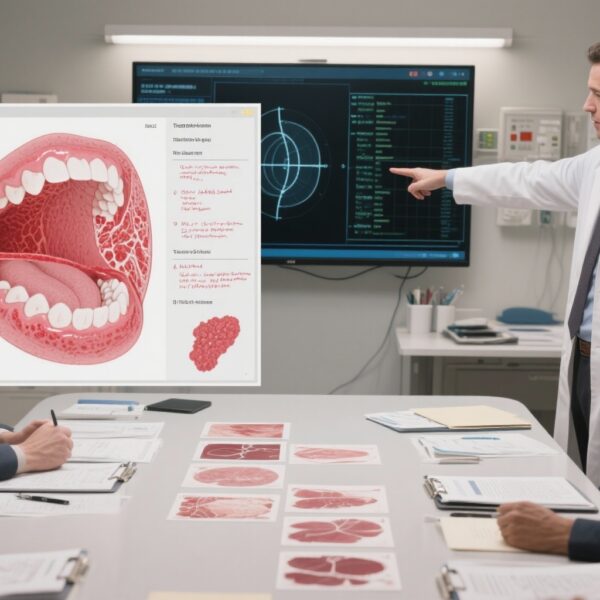Highlight
• In a retrospective, multicenter cohort of 345 patients aged ≥70 undergoing primary surgery for squamous cell carcinoma (SCC) of the tonsil or base of tongue (BOT), p16 positivity (a surrogate for HPV-associated disease) was associated with a 5‑year overall survival (OS) of 71.4% versus 47.7% for p16‑negative tumors (absolute difference 23.7%; adjusted HR for OS 0.36).
• Disease‑free survival (DFS) benefits paralleled OS: 5‑year DFS 66.4% for p16‑positive versus 40.8% for p16‑negative tumors (absolute difference 25.6%; adjusted HR for DFS 0.42).
Background
Oropharyngeal squamous cell carcinoma (OPSCC) arising in the palatine tonsil and base of tongue has undergone an epidemiologic shift over recent decades: human papillomavirus (HPV)–associated tumors now comprise a growing proportion of cases in many high‑income countries and are recognized to have a markedly better prognosis than tobacco‑related disease. Landmark studies established the survival advantage of HPV‑positive OPSCC in largely younger populations, and staging systems (AJCC 8th edition) and treatment pathways reflect HPV status as a major prognostic variable (Ang et al., NEJM 2010; AJCC 8th ed., 2017).
The incidence of HPV‑associated OPSCC among older adults is rising. Older patients present unique management challenges because of comorbidity, frailty, competing mortality risks, and altered tolerance to multimodal therapy. Decision‑making for curative‑intent treatment in patients aged 70 and older therefore requires evidence that the favorable biology conferred by HPV persists in this age group and translates into meaningful survival advantages after specific treatments, including primary surgery.
Study design
The referenced study (Boscolo‑Rizzo et al., JAMA Otolaryngol Head Neck Surg. 2025) is a retrospective cohort analysis performed across 10 comprehensive cancer centers (2010–2021). Inclusion criteria were age ≥70 at diagnosis, biopsy‑proven SCC of the tonsil or BOT that was surgically resectable, and a minimum follow‑up of 3 years. HPV status was defined by p16 immunohistochemistry (p16 IHC), the commonly used surrogate marker per contemporary practice and staging conventions.
Primary outcomes were overall survival (OS) and disease‑free survival (DFS). Survival analyses used Cox proportional hazards models, adjusted for relevant covariates. The cohort included 345 patients (mean age 75.7 years, 69.9% male), of whom 155 (44.9%) were p16‑positive and 190 (55.1%) p16‑negative. Surgical approaches were transoral in 60% and open in 40%.
Key findings
The median follow‑up was 55 months (IQR 18–87 months). Major survival outcomes were:
- 5‑year overall survival: 71.4% for p16‑positive vs 47.7% for p16‑negative; absolute difference 23.7% (95% CI, 13.0%–34.4%); adjusted hazard ratio (HR) for OS 0.36 (95% CI, 0.23–0.57).
- 5‑year disease‑free survival: 66.4% for p16‑positive vs 40.8% for p16‑negative; absolute difference 25.6% (95% CI, 14.9%–36.3%); adjusted HR for DFS 0.42 (95% CI, 0.28–0.63).
These effect sizes are large and clinically meaningful. The p16‑positive group had approximately a 60–64% lower hazard of death and a similar magnitude lower hazard of recurrence compared with p16‑negative patients after adjustment.
Secondary and contextual findings
The study reports that the survival advantage for p16‑positive tumors persisted across surgical approaches (transoral vs open), though subgroup hazard estimates and interaction tests were not detailed in the summary provided here. Median follow‑up exceeding four years strengthens outcome assessment for both locoregional control and survival in this older cohort.
Interpretation and biological plausibility
HPV‑positive OPSCC is biologically distinct: tumors are often more radiosensitive and chemosensitive, have favorable tumor‑immune microenvironments, and exhibit different molecular drivers than tobacco‑related SCC. The persistence of a marked survival benefit in patients aged ≥70 suggests that the underlying tumor biology conferring improved prognosis remains operative in older hosts. While competing comorbidity can attenuate absolute survival gains in older patients, the reported adjusted HRs indicate that HPV status remains an independent and robust prognostic marker in this population.
Clinical implications
1) Risk stratification and counseling: p16 IHC should continue to be used routinely in patients with OPSCC regardless of age. For patients aged ≥70, a p16‑positive result provides strong prognostic information and should inform shared decision‑making about the likely benefits of curative‑intent therapy.
2) Surgical candidacy and approach: The study included substantial numbers treated transorally, supporting use of transoral robotic or endoscopic approaches in selected older patients. Surgical management remains a reasonable primary modality in operable older patients, particularly when functional outcomes and comorbidity favor a single‑modality approach or when deintensification strategies are being considered in multidisciplinary contexts.
3) Adjuvant therapy decisions: Although the study focused on surgical cohorts, clinicians must individualize adjuvant radiation or chemoradiation decisions for older patients, balancing improved locoregional control against toxicity and frailty. The favorable baseline prognosis of p16‑positive tumors may open consideration for treatment de‑intensification trials in older adults, but such changes should be made within clinical trials or after careful multidisciplinary assessment, because older patients were historically underrepresented in trials of de‑escalation.
4) Holistic assessment: In older adults, performance status, comorbidity burden, frailty measures, cognitive function, social support, and patient goals must be integrated with tumor HPV status to craft individualized care plans.
Strengths and limitations
Strengths:
- Multicenter design with a reasonably large sample for an older surgical cohort (n=345) and long median follow‑up.
- Contemporary surgical techniques included (transoral and open), increasing generalizability to current practice.
- Adjusted analyses demonstrating robust associations between p16 status and outcomes.
Limitations:
- Retrospective design introduces potential selection bias: surgical candidates represent a fitter subset of older patients and those selected for surgery may differ systematically by HPV status.
- p16 IHC is a surrogate for HPV oncogenic infection; although widely accepted, p16 positivity can occasionally be discordant with HPV nucleic acid testing. The study used p16 alone, consistent with common clinical practice but less specific than combined testing.
- Detailed data on comorbidities, frailty indices, specific adjuvant therapy regimens, treatment‑related morbidity, and cause‑specific mortality were not provided in the summary; these details are important when applying results to individual patients.
- External generalizability to non‑surgical populations, to centers with different patient selection practices, or to regions with different patterns of HPV prevalence may be limited.
How this fits with prior evidence
Previous landmark studies established improved survival for HPV‑positive OPSCC in largely younger cohorts (Ang et al., NEJM 2010). Epidemiologic analyses have shown rising incidence of HPV‑related OPSCC across age groups (Chaturvedi et al., NEJM 2011). This study extends those observations by demonstrating that the favorable prognosis of HPV‑associated disease persists among older surgical patients—supporting the idea that tumor biology, not just patient age, drives prognosis.
Research and practice gaps
Key unanswered questions include optimal adjuvant strategies for older patients with HPV‑positive disease, the role and safety of treatment de‑escalation in older adults, interactions between frailty/comorbidity and oncologic outcomes, and causes of non‑cancer mortality in this group. Prospective trials or registries that intentionally enroll older adults and collect standardized frailty, functional, and quality‑of‑life metrics are needed.
Conclusion
In this international multi‑center surgical cohort, p16 positivity was associated with substantial and clinically meaningful improvements in both overall and disease‑free survival among patients aged 70 and older undergoing resection for tonsil or BOT SCC. These data support routine assessment of HPV status in older adults and reinforce that HPV‑associated OPSCC retains a favorable prognosis in the elderly. Treatment decisions should nonetheless be individualized, integrating tumor biology with comorbidity, frailty, and patient preferences.
Funding and clinicaltrials.gov
See the original publication for funding and disclosures (Boscolo‑Rizzo et al., JAMA Otolaryngol Head Neck Surg. 2025). This analysis was a retrospective cohort study and is not listed as an interventional clinical trial in ClinicalTrials.gov in the summary provided.
References
Ang KK, Harris J, Wheeler R, et al. Human papillomavirus and survival of patients with oropharyngeal cancer. N Engl J Med. 2010;363(1):24–35.
Chaturvedi AK, Engels EA, Anderson WF, Gillison ML. Incidence trends for human papillomavirus‑related and unrelated oral squamous cell carcinomas in the United States. N Engl J Med. 2011;365(17):1576–1585.
AJCC Cancer Staging Manual. 8th ed. 2017. (Staging changes for head and neck cancers incorporate HPV status.)
Boscolo‑Rizzo P, Tagliabue M, Polesel J, et al. HPV Status and Survival Outcomes in Patients 70 Years and Older After Surgery for Oropharyngeal Carcinoma. JAMA Otolaryngol Head Neck Surg. 2025;151(8):795–805. doi:10.1001/jamaoto.2025.1722.
National Comprehensive Cancer Network (NCCN). NCCN Clinical Practice Guidelines in Oncology: Head and Neck Cancers. Accessed 2024–2025 updates.
Practical takeaways for clinicians
• Order p16 testing for all OPSCC patients regardless of age; use the result to inform prognosis and planning.
• Consider surgery as a curative option for operable older patients with OPSCC when functional status and comorbidity permit; p16 positivity signals a favorable prognosis.
• Use a multidisciplinary approach to balance oncologic control with toxicity risks in adjuvant therapy planning; include geriatric assessment where feasible.
• Encourage enrollment of older patients in prospective trials addressing de‑escalation, tolerability, and quality‑of‑life outcomes.



